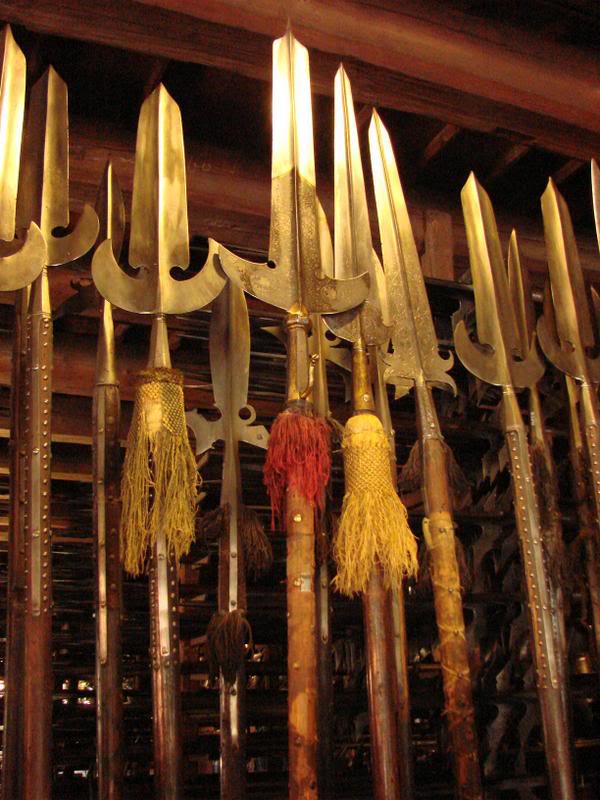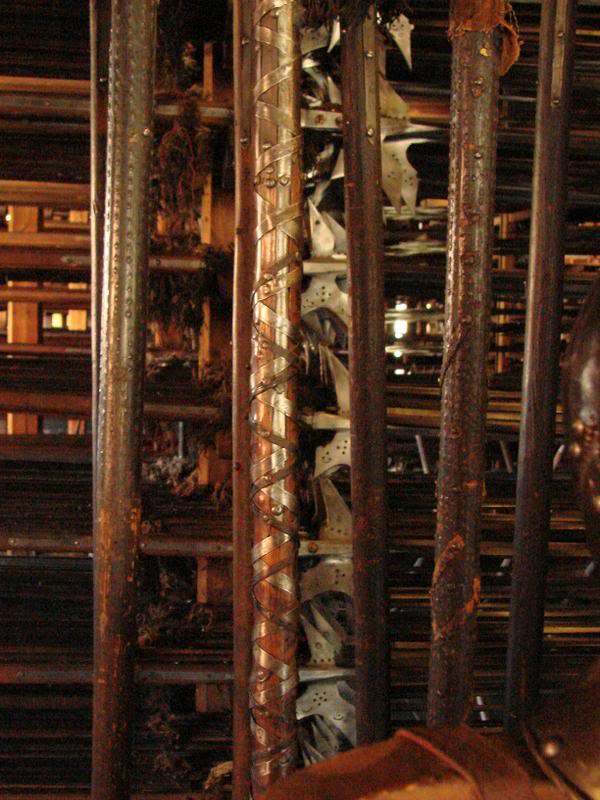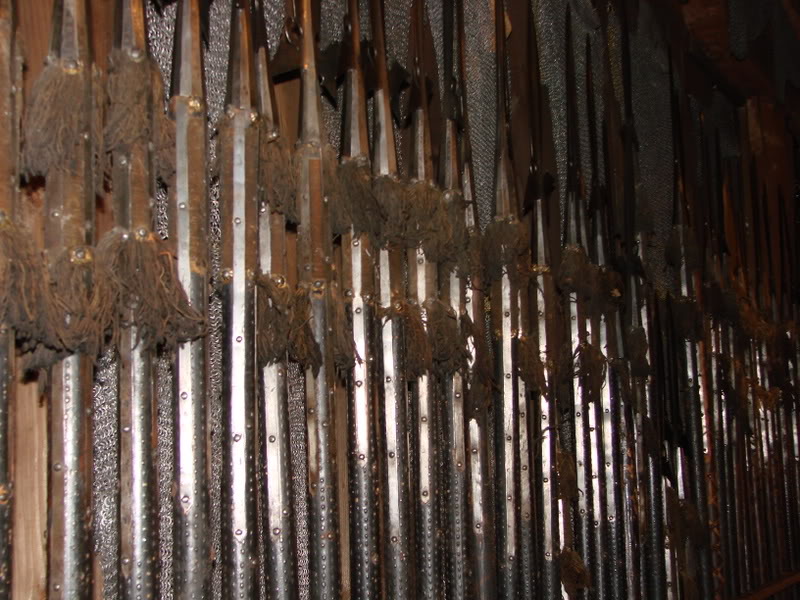So here's the story: I'm in the process of redoing a Cold Steel poleaxe into a shorter two-handed axe. While I'm not trying to make a 100% historically accurate piece, I still would like it to have some historical basis even if it is somewhat of a fantasy piece. My question is did battle axes in history sometimes have wrapped hafts; and if so, what kinds of materials were used? I find that most reproductions are sold with bare hafts. Is there some reason in terms of function or fighting technique that would make a wrapped haft impractical?
-JM
Josh,
I know nothing about this from a historical standpoint, but from a practical point, I would say the shaft would have to be bare, in the area of the fore-most hand, with possibly studs, or leather wrap (or both) for the hand at the end of the handle.
The reason being, the for-most hand must be able to slide over the shaft, whilst the rear hand holds fast to one position.
This is my problem with many stupod axe handles made these days....They put on a thick non-slip surface, and the hand can't slide.
Looking at this from the perspective of a battle-axe, recovery time could be fatal if the hand couldn't slide up to the head.
If you are intending on this project being a short pole-arm, then a stop in front of the hand is ok, to aid in a tthrust, but this would really slow down manouverability in swinging it..
R.
I know nothing about this from a historical standpoint, but from a practical point, I would say the shaft would have to be bare, in the area of the fore-most hand, with possibly studs, or leather wrap (or both) for the hand at the end of the handle.
The reason being, the for-most hand must be able to slide over the shaft, whilst the rear hand holds fast to one position.
This is my problem with many stupod axe handles made these days....They put on a thick non-slip surface, and the hand can't slide.
Looking at this from the perspective of a battle-axe, recovery time could be fatal if the hand couldn't slide up to the head.
If you are intending on this project being a short pole-arm, then a stop in front of the hand is ok, to aid in a tthrust, but this would really slow down manouverability in swinging it..
R.
Some polearms from Graz, Austria, that demonstrate both "studded" and "smooth".



Hope this helps.



Hope this helps.
| B. Fulton wrote: |
| Some polearms from Graz, Austria, that demonstrate both "studded" and "smooth".
|
And at least two covered with some kind of textile. I've seen fabric-covered hafts from time to time in other places too. Interesting.
Are you talking about the "ruffle" (can't remember the proper name) just below the spear/axe/polearm head?
Those are intended to keep rain off the shaft (and your hands from slipping) among other things.
Those are intended to keep rain off the shaft (and your hands from slipping) among other things.
I think those are called tassets.
How are the studs applied? Are they round headed nails carefully driven into place?
M.
How are the studs applied? Are they round headed nails carefully driven into place?
M.
| B. Fulton wrote: |
| Are you talking about the "ruffle" (can't remember the proper name) just below the spear/axe/polearm head?
Those are intended to keep rain off the shaft (and your hands from slipping) among other things. |
If you're asking me, no, I'm speaking of the whole haft (or large portions of it) being covered in a textile.
I've cropped one of your pics to show a textile-covered haft.

Got it........was trying to figure out just which ones you were talking about. We spent over half a day in there, taking pictures of basically "everything" with permission to handle the pieces (with gloves) so we were happily disassembling armor, picking up 300-year old halberds, etc....
I took a ton of photos, these are just a few.
I took a ton of photos, these are just a few.
| M. Eversberg II wrote: |
| I think those are called tassets.
|
Tassels. Tassets are a piece of armour :).
Johan Schubert Moen
I think the question Josh posted originally was regarding a two-handed axe, rather than polearms. (But I could be wrong!)
Mr B Fulton;
Lovely pictures!! Do you have any pics of battle-axes?
best wishes,
Richard.
Mr B Fulton;
Lovely pictures!! Do you have any pics of battle-axes?
best wishes,
Richard.
None from Graz. I may have one from the Tower of London, a Scottish axe actually made in Russia, captured during the 1600s.
I'll have to look around for some others. If you're not picky about period, I have a large number of pics from the Louvre with Egyptian/Sassanian/Mesopotamian bronze axes.
Since I took over 4,000 photos in the Louvre, Cluny, Les Invalides, Leeds, York, the Tower of London, Victoria & Albert, and a few other museums, finding just battle axes might take a bit. :)
That's not counting Graz, or any of the OTHER museums I've hit since 2005.....
I'll look though.
I'll have to look around for some others. If you're not picky about period, I have a large number of pics from the Louvre with Egyptian/Sassanian/Mesopotamian bronze axes.
Since I took over 4,000 photos in the Louvre, Cluny, Les Invalides, Leeds, York, the Tower of London, Victoria & Albert, and a few other museums, finding just battle axes might take a bit. :)
That's not counting Graz, or any of the OTHER museums I've hit since 2005.....
I'll look though.
Haha my original question was geared more towards two-handed axes. But that's the magic of forums; sometimes the discussions can move a bit off topic. But no harm done ;) But if anyone could post some examples of handle wrappings on historical two handed axes, that would be great. I'll try and find some to post as well.
-JM
-JM
Josh,
I just finished doing the same thing to my CS pole axe (for $30, how could I resist!). I ended up just leaving the entire haft plain (no grip or studding) and sanded it down (mine had some rough spots) then stained it. My OAL is around 48", and it swings quite nicely. Not even remotely historically accurate, but serviceable for a wide variety of uses (I used mine to take down an old dogwood).
I might wrap the end of the haft in leather and then stud part of the grip for looks later on, but as it is, even in the hot Georgia sun (and lots of sweat) I had no problems with maintaining a sure and steady grip on it.
I just finished doing the same thing to my CS pole axe (for $30, how could I resist!). I ended up just leaving the entire haft plain (no grip or studding) and sanded it down (mine had some rough spots) then stained it. My OAL is around 48", and it swings quite nicely. Not even remotely historically accurate, but serviceable for a wide variety of uses (I used mine to take down an old dogwood).
I might wrap the end of the haft in leather and then stud part of the grip for looks later on, but as it is, even in the hot Georgia sun (and lots of sweat) I had no problems with maintaining a sure and steady grip on it.
[ Linked Image ]
Horseman's axe from Leeds. German, I believe.
[ Linked Image ]
Egyptian axe recovered from a tomb. Two handed, plain shaft (not shown for size) and the shaft appears original.
[ Linked Image ]
Polearms from the Musee de l'Armee (Les Invalides). Halberd is smooth shafted, the others are studded, the leftmost is studded and wrapped.
[ Linked Image ]
[ Linked Image ]
An interesting axehead, but the rest is missing......
Horseman's axe from Leeds. German, I believe.
[ Linked Image ]
Egyptian axe recovered from a tomb. Two handed, plain shaft (not shown for size) and the shaft appears original.
[ Linked Image ]
Polearms from the Musee de l'Armee (Les Invalides). Halberd is smooth shafted, the others are studded, the leftmost is studded and wrapped.
[ Linked Image ]
[ Linked Image ]
An interesting axehead, but the rest is missing......
From the Neuburg, in Vienna.

All these halberds appear to be smooth, no studs, wrapping, leather, etc.

An interesting one for you. Also smooth.

Some more polearms from Graz.
[/img]

All these halberds appear to be smooth, no studs, wrapping, leather, etc.

An interesting one for you. Also smooth.

Some more polearms from Graz.
[/img]
Found some battle axes for you!
From the Staadtsmuseum in Munich yesterday.
[ Linked Image ]
[ Linked Image ]
[ Linked Image ]
And some polearms just because.
[ Linked Image ]
[ Linked Image ]
Enjoy!
From the Staadtsmuseum in Munich yesterday.
[ Linked Image ]
[ Linked Image ]
[ Linked Image ]
And some polearms just because.
[ Linked Image ]
[ Linked Image ]
Enjoy!
Page 1 of 1
You cannot post new topics in this forumYou cannot reply to topics in this forum
You cannot edit your posts in this forum
You cannot delete your posts in this forum
You cannot vote in polls in this forum
You cannot attach files in this forum
You can download files in this forum
All contents © Copyright 2003-2006 myArmoury.com — All rights reserved
Discussion forums powered by phpBB © The phpBB Group
Switch to the Full-featured Version of the forum
Discussion forums powered by phpBB © The phpBB Group
Switch to the Full-featured Version of the forum